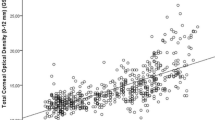Abstract
The spectral transmissions of cornea, aqueous humour, lens and vitreous humour of human eyes were measured in the range from 250 nm to 800 nm in 1 nm steps using a high resolution double monochromator. Cornea and lens are good cut off filters; 1% transmission was measured in various cornea samples between 291 and 298 nm, and in different lenses between 389 and 414 nm. Aqueous humour and vitreous humour showed high transparency (80%) at⋋ >320 nm. The wavelength range of keratitis effective irradiance was found to be completely within the wavelength range of absorption of the cornea, that of cataract effective irradiance was found to be at the short wavelength end partly outside the wavelength range of absorption of the lens. It may therefore be supposed that the action spectrum of cataract obtained by animal experiments is applicable to the human eye only with certain reservations.
Access this article
We’re sorry, something doesn't seem to be working properly.
Please try refreshing the page. If that doesn't work, please contact support so we can address the problem.
Similar content being viewed by others
References
Staehelin J, Blumthaler M, Ambach W, Torhost J. Skin cancer and the ozone shield. Lancet 1990; 336: 502.
Blumthaler M, Ambach W. Indication of Increasing Solar Ultraviolet-B Radiation Flux in Alpine Regions. Science 1990; 248: 206.
Anonymous. Protecting man from UV exposure. Lancet 1991; 337: 1258.
Crutzen PJ. Ultraviolet on the increase. Nature 1992; 356: 104.
DIN 5031. Deutsche Normen, Strahlungsphysik im optischen Bereich und Lichttechnik. Teil 10 (Vornorm). Berlin: Beuth Verlag, 1979: 1–8.
Taylor HR. Effect of ultraviolet radiation on cataract formation. New Eng J Med 1988; 313: 789.
Dillon J. The photophysics and photobiology of the eye. J Photochem Photobiol B Biol 1991; 10: 23.
Bachem A. Ophthalmic ultraviolet action spectra. Am J Ophthalm 1956; 41: 969.
Hoover HL. Solar ultraviolet irradiation of human cornea, lens, and retina: equations of ocular irradiation. Applied Optics 1986; 25: 359.
Stevens MA, Bergmanson JP. Does sunlight cause premature aging of the crystalline lens? J Optometric Assn 1989; 60: 660.
Wyszecki G, Stiles WS. Color Science: Concepts and methods, quantitative data and formula. 2nd edition John Wiley & Sons, Inc. 1982; New York, Chichester, Brisbane, Toronto, Singapore
Beems EM, Van Best JA. Light transmission of the cornea in whole human eyes. Exp Eye Res 1990; 50: 393
Boettner EA, Wolter JR. Transmissioon of the ocular media. Invest. Ophthalmol. 1962; 1: 776–783
Wolf E, Gardiner JS. Studies on the scatter of lights in the dioptic media of the eye as a basis of visual glare. Arch. Ophthalmol. 1965; 74: 338–345
Said FS, Weale RA. The variation with age of the spectral transmissivity of the living human crystalline lens. Gerontologia 1959; 3: 213
Weale RA. Light absorption by the lens of the human eye. Optica Acta 1954; 1: 107–110
Boettner EA. Spectral transmission of the eye. USAF School of Aerospace Medicine, Texas, Univ. of Michigan, Contract AF 41 (609)-2966, 1967.
Wright WD. The visual sensitivity of normal and aphakic observers in the ultraviolet. Anné Psycho-Physiologie 1951; 50: 169–176
CIE Proceedings 1951, Vol. 1, Sec. 4; Vol. 3, p 37, Bureau Central de la CIE, Paris 1951
Dartnall HJA. The interpretation ofspectral sensitivity curves. Brit. Med. Bull 1953; 9: 24
Norren DV, Vos JJ. Spectral transmission of the human ocular media. Vis. Res. 1974; 14: 1237–1243
Alpern M, Thompson S, Lee MS. Spectral transmittance of visible light by the living human eye. J. Opt. Soc. Am. 1965; 55: 723–727
Mellerio J. Light absorption and scatter in the human lens. Vis. Res. 1971; 11: 129–141
Author information
Authors and Affiliations
Rights and permissions
About this article
Cite this article
Ambach, W., Blumthaler, M., Schöpf, T. et al. Spectral transmission of the optical media of the human eye with respect to keratitis and cataract formation. Doc Ophthalmol 88, 165–173 (1994). https://doi.org/10.1007/BF01204614
Accepted:
Issue Date:
DOI: https://doi.org/10.1007/BF01204614




